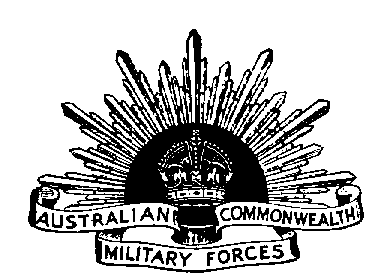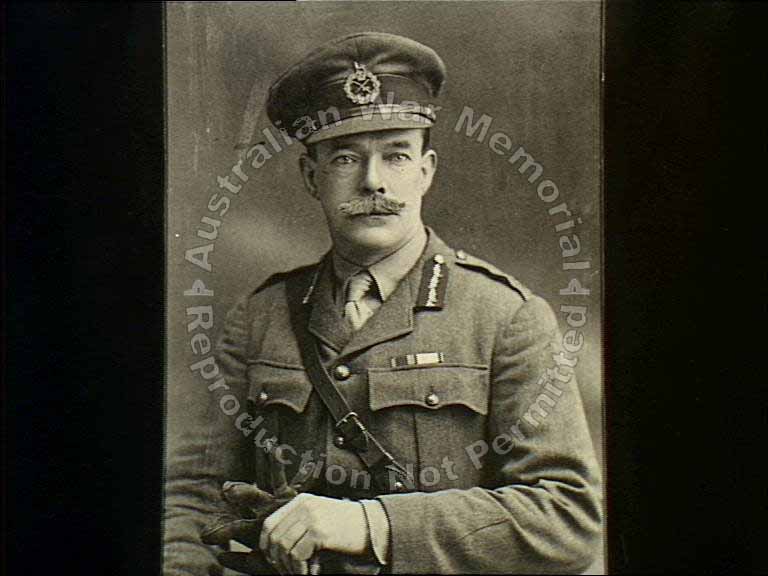


AWM negative Number: P02205.001 Caption: England. c. 1916. Studio portrait of Major E. A. Wisdom (later Brigadier Wisdom (Donor E. Evans)
Evan Alexander Wisdom was born in Inverness, Scotland on 29 September 1869, the son of a music seller. He was educated in Inverness and Edinburgh. In 1891, he emigrated to Western Australia where he became a gold prospector. Wisdom joined the gold rushes at Yilgarn, Coolgardie and Kalgoolie. He was successful and acquired a number of mining interests and established the Exchange Hotel.
In Scotland, Wisdom had joined the militia and had served in the infantry and the Midlothian Coast Artillery. In 1901, he was commissioned as a lieutenant the Western Australian Mounted Infantry. He was given command of the Cannington Troop and promoted to captain in 1903. He served with militia headquarters in Perth and became brigade major of the Western Australian Infantry Brigade in 1908.
From 1908 to 1913, Wisdom was mayor of Cottesloe. He was also the member for Clarement in the Western Australian Legislative Council from 1911 to 1917.
When the war broke out in 1914, Wisdom was placed in charge of the Karrakatta training camp. In March 1915, he was appointed to the AIF with the rank of major as brigade major of the 5th Infantry Brigade. He arrived at Gallipoli with the brigade in August 1915.
During the evacuation of Anzac, Wisdom served as staff officer of the Rear Party under the command of Colonel J. Paton. He supervised the final arrangements. At 4am, the last lighter sailed from North Beach and Paton, Wisdom and some other staff officers waited alone at the pier for any stragglers. None came and they embarked in a steamboat ten minutes later. The last man to leave Anzac was the seaman who cast off the line on their boat. For his services at Gallipoli, Wisdom was awarded the Distinguished Service Order.
In Egypt, Wisdom was given command of the 18th Infantry Battalion in February 1916 and took this battalion to France the next month. At Pozieres his battalion was heavily shelled, not just by the enemy, but by the Anzac Artillery, which caused some 150 casualties.
When Paton was wounded in November 1916, Wisdom took over command of the 7th Infantry Brigade and was promoted to colonel and temporary brigadier general. Wisdom led the attack on Malt Trench in March 1917, and at the Battle of Lagnicourt later that month, when his brigade was beat off a German counterattack. Later in the year, the brigade fought at Menin Road and Broodeseinde.
In 1918 7th Brigade was engaged at Morlancourt in June 1918, Hamel in July 1918, Amiens in August 1918, Mont St Quentin in September 1918 and the Beaurevoir Line in October 1918.
In August 1918, Wisdom commanded the "Liaison Force", a division sized force built around the 13th Infantry Brigade and the US 131st Infantry which was tasked with clearing the region north of the Somme River, on the Australian Corps' flank.
For his services on the Western Front, Wisdom was made a CMG. He was mentioned in dispatches six times. In 1919, he served with the AIF's Demobilization and Repatriation Department in London. He returned to Australia in December 1919.
After the war Wisdom was appointed chairman of the Central War Gratuities Board in May 1920. On 21 March 1921 he succeeded Brigadier General T. Griffiths as Military Administrator of New Guinea. By this time the military administration of New Guinea was coming to an end and Wisdom's first task was to covert the administration from a military to a civil one. On 9 May 1921, civil government was established in New Guinea, and Wisdom became the civilian Administrator.
As administrator, Wisdom tried his best to comply with the terms of Australia's League of nations mandate over the territories, governing them for the best welfare of the people. In this he had to cope with the less than enlightened attitudes of the terms, particularly of the plantation owners. From 1930, the onset of the great depression reduced the prices of the commodities that the territories depended on and government activities were curtailed to reduce costs. In March 1932 he opened the Bulolo Gold Dredging Company and fiscal problem receded as gold production picked up. Wisdom left Rabaul in June 1932 and retired in June 1933, returning to his pre-war mining interests in Western Australia.
Wisdom died in Melbourne on 7 December 1945 and was cremated. The official historian described him as "one of the best leaders in the AIF"
Sources: Australian Dictionary of Biography, 1899-1939, Vol 12, p. 546; Bean, C. E. W., The Official History of Australia in the War of 1914-1918. Volume II: The Story of Anzac pp. 878, 896; Volume III: The AIF In France 1916, pp. 662, 172-175; Volume IV: The AIF In France 1917, pp. 97, 198; MacKenzie S. S., Volume X: The Australians at Rabaul, p. 360
Page created by Ross
Mallett
ross@metva.com.au
Last update 8 June 2010